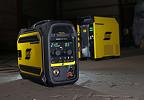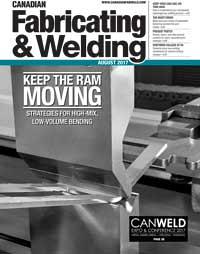Editor
- FMA
- The Fabricator
- FABTECH
- Canadian Metalworking
Welding preheat practices: choose the right tool for your job
While using a torch to preheat your welds may seem simple enough to suit your job, is it doing the job correctly?
- By Rob Colman
- August 22, 2017
- Article
- Welding

Preparing an electrical resistance preheat on a large piece of machinery. Image courtesy of KASI Technologies Inc.
Preheating is an important preparatory operation for certain welding jobs. As the name implies, it is the process of raising the temperature of a part before welding it. This preheat temperature has to be maintained throughout the welding procedure. In some cases it might be necessary to continue heating the part during welding, but sometimes the heat input from the welding itself maintains that temperature. The interpass temperature, which is the base metal temperature maintained between the first and last welding passes, should not fall below the preheat temperature.
Preheat is recommended for certain jobs for several reasons. Among these is that it helps stave off moisture from the base metal and weld, which in turn makes the completed part less susceptible to hydrogen cracking. It also reduces shrinking stresses in both the base metal and the weld joint. Generally speaking, preheating helps ensure that the weld has the mechanical properties it was designed to achieve.
Torch Heating
Essentially three methods commonly are used to preheat joints: propane (gas) torch, induction heating, and electrical resistance heating.
“Torch heating is certainly the most portable of the three methods,” said Scott Fong, owner and general manager of KASI Technologies Inc., an Edmonton company that specializes in renting industrial heating, welding, and bolting equipment. “Basically, torch heating is like using a big barbecue lighter. It’s just a torch and you simply monitor its temperature with temperature-indicating sticks. Once you see the sticks melt, you know you’ve reached the minimum preheat temperature and you start welding.”
While Fong appreciates the portability and affordability of this method, he also notes that it is, by its very nature, not as accurate as the other technologies available.
“It is very easy to overheat the steel past your maximum interpass temperatures,” he explained. “You also don’t get even heating all the way around the surface. You’ve got to manipulate the torch a lot. Once the welder starts welding, he may be able to keep the weld at the minimum preheat temperature via the welding process itself; however, on thicker sections of steel, the heat tends to bleed out very quickly. In situations like that, it’s important to have a more controlled preheat process.”
Induction Heating
The most common methods for achieving a more controlled preheat temperature are induction heating and electrical resistance heating.
“The equipment used for induction is considerably more expensive than that used for electrical resistance heating,” said Fong. “However it does get your steel hotter quicker. It still offers you much more control than what you achieve with a torch.”
The induction method of preheating can use either a liquid-cooled braided hose or an air-cooled premade blanket wrapped around the material to be heated to create a magnetic field. The magnetic field excites the molecules in the material, which creates heat that radiates from the center of the material outward in all directions.
With an induction heating system you attach a thermocouple to the weld. The thermocouple senses the temperature of the steel and sends a signal back to the controller on the induction machine. Once the steel reaches the preheat temperature, it will maintain that temperature until the controller is adjusted.
“It is very quick,” said Fong. “It has its ideal applications. For instance, when a shop is heating very thick sections of pipe and rotating them, this can be a good solution. Its limitation is that an induction machine can be used to heat just one weld joint at a time, and it has only a single point of control.”
Electrical Resistance Heating
A standard electrical resistance preheating machine, on the other hand, is built as a six-way unit, which means it is equipped to heat three joints at the same time, while offering six points of control.
Similar to the induction method, the pipe gets wrapped. However, the coils (flexible ceramic pads) that are used heat through conduction, and therefore heat from the outside going into the steel. The electrical resistance method (sometimes referred to as Cooperheat) also controls the preheat by using the feedback of a thermocouple.
“It allows you more control, in the sense that you can add more controlling thermocouples,” said Fong. “For materials like P91 alloy steel, where you need to tightly monitor your maximum interpass temperature and your preheat temperature, the electrical resistance method gives you more control over that. P91 is becoming widely used in power plants and other high-temperature applications. So in circumstances where you are using this type of material, using electrical resistance allows you to control each 120 sq. in. of steel. It is also your most effective method of controlling maximum interpass.”
Fong also noted that the equipment is simpler and more durable for field applications.
“It is a little slower with respect to actually setup, but when you are welding thick sections, that speed isn’t as big a concern because you can prepare for more welds at once,” he explained. “Preheat time could also be a half hour compared to five minutes. That depends on the power available and the setups, so it is harder to quantify.”
Fong pointed to one company he worked with that saved enough money from switching from using torch heating to an electrical resistance system that the equipment paid itself off in about six months.
Track Your Heat
Although both induction and electrical resistance monitor preheat temperature, Fong urges welders to continue to use temperature-indicating sticks to ensure they have reached the correct temperature.
“You should always use temperature-indicating sticks because, for instance, the thermocouple measures at only one point on that piece of pipe. You are responsible for having minimum preheat temperature on the whole area within 3 in. of where you are welding. If you are on an 8-in.-diameter pipe and you have two thermocouples, one on each side of the section of pipe you are going to weld – they are diametrically opposed – you’ve got 6 in. of coverage there on 24 in. of circumference. You should be using temperature-indicating sticks. It’s not worth slapping on a thermocouple every 3 in. That is just overkill.
“Welders should always carry temperature-indicating sticks in their pockets, one minimum for the preheat temperature, and one for the maximum interpass temperature as per the WPS/PRQ requirements,” Fong continued. “The controller may say 350 degrees, but it’s reading only that one thermocouple at that one spot.”
Fong also encourages those using preheat equipment to get some proper training before engaging with the technology.
“We have field heat treatment technicians out there in the field,” he pointed out. “It is a Designated Occupation in Alberta. However, with the right training, you can gain a great deal of time savings utilizing induction or electrical resistance preheat equipment and avoid the problems that can arise when you don’t have the training.”
Editor Robert Colman can be reached at rcolman@canadianfabweld.com.
KASI Technologies Inc., 855-527-4226, www.kasi.caAbout the Author

Rob Colman
1154 Warden Avenue
Toronto, M1R 0A1 Canada
905-235-0471
Robert Colman has worked as a writer and editor for more than 25 years, covering the needs of a variety of trades. He has been dedicated to the metalworking industry for the past 13 years, serving as editor for Metalworking Production & Purchasing (MP&P) and, since January 2016, the editor of Canadian Fabricating & Welding. He graduated with a B.A. degree from McGill University and a Master’s degree from UBC.
subscribe now


Keep up to date with the latest news, events, and technology for all things metal from our pair of monthly magazines written specifically for Canadian manufacturers!
Start Your Free Subscription- Trending Articles
CWB Group launches full-cycle assessment and training program

Achieving success with mechanized plasma cutting

3D laser tube cutting system available in 3, 4, or 5 kW

Brushless copper tubing cutter adjusts to ODs up to 2-1/8 in.

Welding system features four advanced MIG/MAG WeldModes

- Industry Events
MME Winnipeg
- April 30, 2024
- Winnipeg, ON Canada
CTMA Economic Uncertainty: Helping You Navigate Windsor Seminar
- April 30, 2024
- Windsor, ON Canada
CTMA Economic Uncertainty: Helping You Navigate Kitchener Seminar
- May 2, 2024
- Kitchener, ON Canada
Automate 2024
- May 6 - 9, 2024
- Chicago, IL
ANCA Open House
- May 7 - 8, 2024
- Wixom, MI















